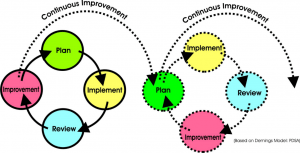Continuous Quality Improvement
Continuous Quality Improvement
The quality system embraces the concept of continuous improvement which is underpinned by the systems theory approach. The notion of continuous quality improvement is a systematic and implies an institution-wide approach for continually improving all processes that deliver quality services to support the core activities of the university.
The system has a strong stakeholder focus. It regards the staff and students of the university as the primary stakeholders and a range of external entities as secondary stakeholders. VUTs quality system is based on the continuous improvement model of Plan-Implement-Review-Improve (PIRI). This model is an adapted model from Deming’s PDSA (Plan-Do-Study-Act) and Plan-Do-Check-Act (PDCA) models. The continuous improvement model implies that appropriate objectives should be set during planning, that plans should be implemented to achieve the objectives, that the implementation of plans implies continuous measuring/reviews and finally that certain adjustments should be made in order to achieve the objectives set, which results in adjustments and eventually, improvement.
Based on Demings Model: PDSA _ PIRI cycle of continuous improvement
The following are characteristic of the quality assurance system of VUT:
Customer or stakeholder focused: Students and staff are regarded as internal stakeholders and external stakeholders are regarded as professional bodies, parents, industry, government, HEQC, DoHET and so forth.
Fitness for and of purpose: The quality assurance system ensures the realization of the national demands and legislative requirements for VUT (fitness of purpose) as well as the realization of the vision and mission of VUT (fitness for purpose).
Culture for quality: In order to achieve a culture for quality, the management, staff and students should take
Developmental approach:All quality related activities follow a developmental and not a punitive approach.





